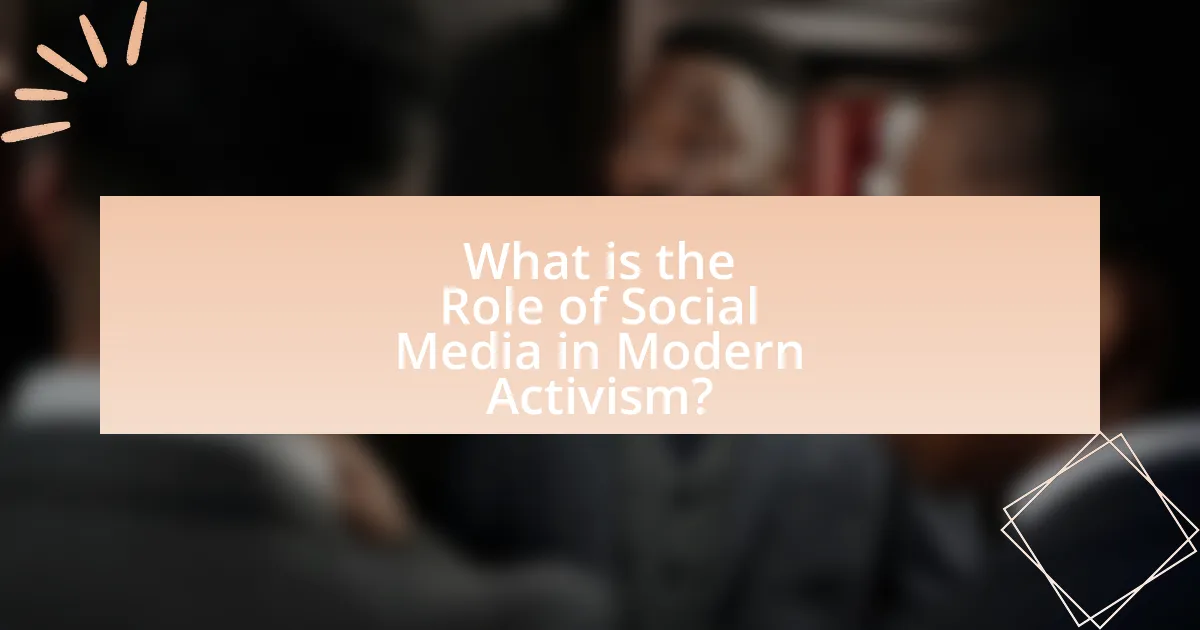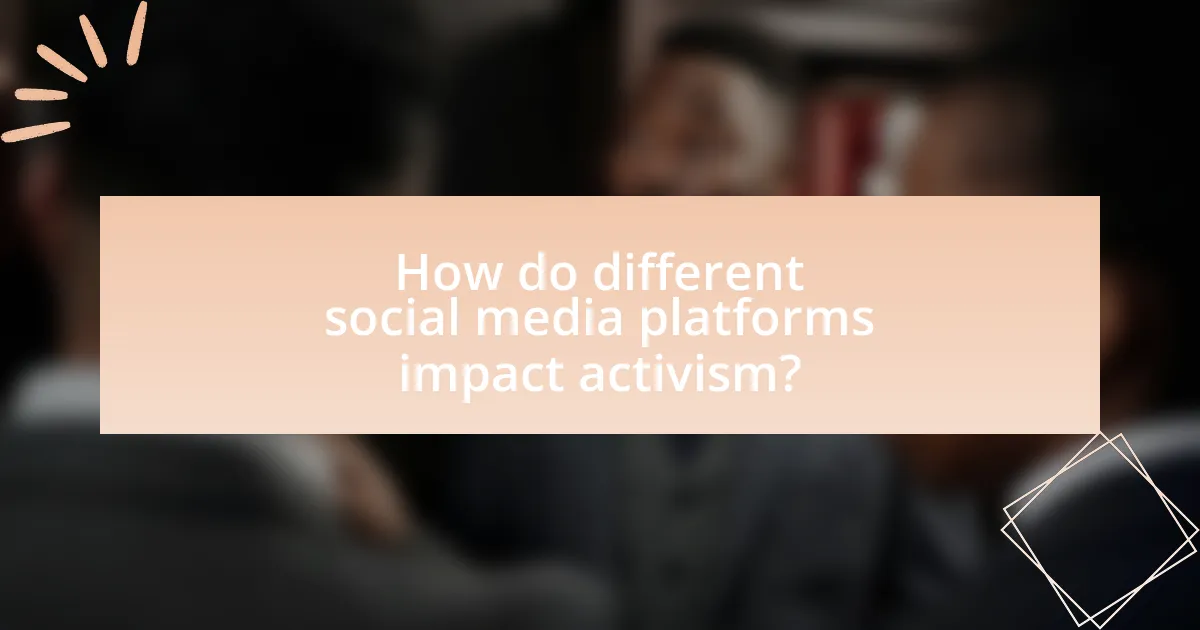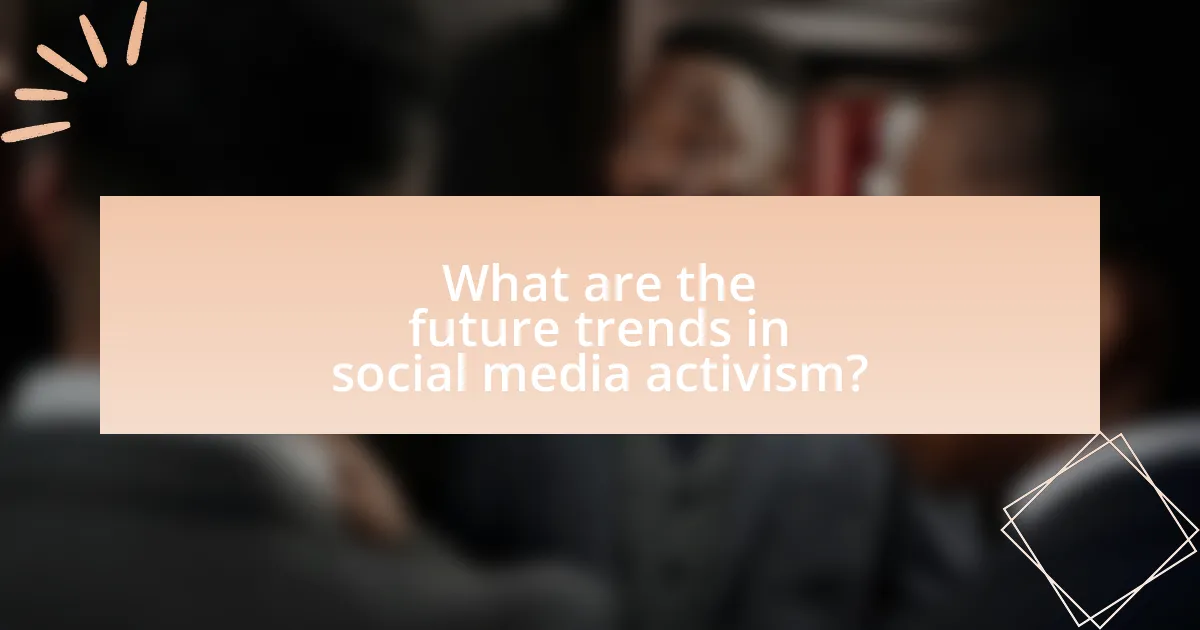The article examines the significant role of social media in modern activism, highlighting how platforms like Twitter, Facebook, and Instagram facilitate rapid communication, mobilization, and awareness-raising among diverse groups. It contrasts traditional activism with social media-driven activism, emphasizing the advantages of digital platforms in reaching global audiences and fostering community engagement. Key challenges faced by activists, such as misinformation and censorship, are also discussed, along with strategies for effective social media engagement. Additionally, the article explores how different social media platforms impact activism and the future trends shaping this landscape.

What is the Role of Social Media in Modern Activism?
Social media plays a crucial role in modern activism by facilitating rapid communication, mobilization, and awareness-raising among diverse groups. Platforms like Twitter, Facebook, and Instagram enable activists to share information instantly, organize events, and engage with a global audience. For instance, the #BlackLivesMatter movement gained significant traction through social media, leading to widespread protests and policy discussions following incidents of racial injustice. Research indicates that social media campaigns can increase public engagement and support for social causes, as seen in the 2019 climate strikes organized by youth activists, which reached millions worldwide through online platforms. Thus, social media serves as a powerful tool for amplifying voices, fostering community, and driving social change in contemporary activism.
How has social media transformed traditional activism?
Social media has transformed traditional activism by enabling rapid communication, broader reach, and increased engagement among activists and supporters. Platforms like Twitter and Facebook allow movements to disseminate information instantly, mobilize supporters quickly, and create viral campaigns that can reach millions globally. For instance, the #BlackLivesMatter movement gained significant traction through social media, leading to widespread protests and policy discussions following incidents of police violence. This shift from traditional methods, such as print media and in-person gatherings, to digital platforms has democratized activism, allowing diverse voices to participate and share their experiences, thus amplifying the impact of social movements.
What are the key differences between traditional activism and social media-driven activism?
Traditional activism primarily relies on in-person engagement, such as protests, rallies, and community organizing, while social media-driven activism utilizes online platforms to mobilize support and spread awareness. Traditional activism often requires significant time and resources to organize events, whereas social media activism allows for rapid dissemination of information and can reach a global audience instantly. For example, the Women’s March in 2017 was organized through social media, demonstrating how online platforms can facilitate large-scale participation without the logistical challenges of traditional methods. Additionally, social media activism can create a sense of community and solidarity among diverse groups, as seen in movements like #BlackLivesMatter, which gained momentum through Twitter and Instagram, highlighting the effectiveness of digital engagement in modern activism.
How do social media platforms facilitate activism?
Social media platforms facilitate activism by providing a space for rapid information dissemination and community mobilization. These platforms enable activists to share messages, organize events, and rally support quickly, often reaching a global audience within minutes. For instance, during the Arab Spring, social media was instrumental in coordinating protests and sharing real-time updates, which significantly contributed to the movements’ visibility and impact. Additionally, studies show that social media campaigns can increase public engagement and awareness, as seen in movements like Black Lives Matter, where hashtags and viral posts have sparked widespread discussions and actions against racial injustice.
Why is social media important for modern activists?
Social media is crucial for modern activists because it provides a platform for rapid communication and mobilization. Activists can disseminate information quickly, reaching a global audience and fostering community engagement. For instance, during the Arab Spring, social media played a pivotal role in organizing protests and sharing real-time updates, which significantly contributed to the movements’ visibility and impact. Additionally, studies show that social media campaigns can increase participation in social movements, as seen in the #BlackLivesMatter movement, which utilized platforms like Twitter and Instagram to raise awareness and drive action against racial injustice.
What advantages does social media provide for raising awareness?
Social media provides significant advantages for raising awareness by enabling rapid information dissemination and fostering community engagement. The platforms allow messages to reach a global audience instantly, which is crucial for mobilizing support during social movements. For instance, the #BlackLivesMatter movement gained traction through Twitter and Instagram, leading to widespread awareness and participation in protests. Additionally, social media facilitates the sharing of personal stories and experiences, creating emotional connections that enhance empathy and understanding among users. According to a Pew Research Center study, 69% of adults in the U.S. use social media, highlighting its potential reach for awareness campaigns.
How does social media enhance community building among activists?
Social media enhances community building among activists by providing platforms for communication, collaboration, and mobilization. These platforms facilitate real-time interaction, allowing activists to share information, organize events, and rally support for causes. For instance, during the Arab Spring, social media was instrumental in coordinating protests and disseminating information, which significantly contributed to the movement’s momentum. Additionally, studies show that social media fosters a sense of belonging and solidarity among activists, as it enables them to connect with like-minded individuals across geographical boundaries, thereby strengthening their collective identity and purpose.
What challenges do activists face when using social media?
Activists face significant challenges when using social media, including censorship, misinformation, and digital surveillance. Censorship can occur when platforms restrict or remove content that is deemed controversial or politically sensitive, limiting the reach of activist messages. Misinformation spreads rapidly on social media, which can undermine campaigns and confuse the public about key issues. Additionally, digital surveillance by governments or organizations can lead to the identification and targeting of activists, posing risks to their safety and privacy. According to a report by Freedom House, 2021, 73% of countries experienced a decline in internet freedom, highlighting the pervasive nature of these challenges.
What are the risks of misinformation in social media activism?
Misinformation in social media activism poses significant risks, including the potential to mislead public opinion and undermine legitimate causes. When false information spreads, it can create confusion, erode trust in credible sources, and polarize communities. For instance, a study by the Pew Research Center found that 64% of Americans believe that misinformation has a major impact on public discourse, which can lead to misguided actions and ineffective activism. Additionally, misinformation can divert resources and attention away from critical issues, ultimately hindering the effectiveness of social movements.
How can activists combat online harassment and censorship?
Activists can combat online harassment and censorship by employing digital security measures, fostering community support, and advocating for policy changes. Digital security measures include using encrypted communication tools and strong passwords to protect personal information, which can reduce vulnerability to harassment. Building community support through networks and alliances allows activists to share experiences and strategies, creating a collective response to harassment. Additionally, advocating for policy changes, such as stronger regulations against online harassment and improved platform accountability, can lead to systemic improvements in how online spaces are managed. These strategies are supported by research indicating that collective action and policy advocacy can effectively reduce instances of online abuse and enhance user safety.

How do different social media platforms impact activism?
Different social media platforms impact activism by shaping the way information is disseminated, mobilizing supporters, and influencing public discourse. For instance, Twitter’s character limit encourages concise messaging, making it effective for real-time updates and rapid mobilization during events like protests. In contrast, Facebook allows for more detailed narratives and community building, facilitating event organization and fostering group discussions. Instagram’s visual focus enhances emotional engagement, which can amplify awareness and support for causes through compelling imagery. Research by the Pew Research Center indicates that 69% of adults in the U.S. use Facebook, making it a powerful tool for reaching a broad audience, while Twitter’s 22% user base is particularly influential among journalists and policymakers, thus impacting media coverage of activist movements. These platform-specific characteristics dictate how effectively activists can communicate their messages and rally support, ultimately influencing the success of their campaigns.
What unique features do various platforms offer for activism?
Various platforms offer unique features that enhance activism, such as Twitter’s real-time updates, which facilitate rapid dissemination of information and mobilization during events. Facebook provides extensive group functionalities, allowing activists to create communities for organizing and sharing resources. Instagram’s visual storytelling capabilities enable impactful narratives through images and videos, attracting wider audiences. TikTok’s algorithm promotes viral content, allowing grassroots movements to gain visibility quickly. Each platform’s distinct features cater to different aspects of activism, from awareness to community building, thereby amplifying the reach and effectiveness of social movements.
How does Twitter facilitate real-time activism?
Twitter facilitates real-time activism by enabling instantaneous communication and information sharing among users. The platform allows activists to disseminate updates, mobilize supporters, and coordinate actions quickly, often in response to unfolding events. For instance, during the Arab Spring, Twitter was instrumental in organizing protests and sharing critical information, demonstrating its capacity to connect individuals and amplify voices in urgent situations. This immediacy and reach empower movements to gain traction and visibility, influencing public opinion and policy in real time.
What role does Instagram play in visual storytelling for causes?
Instagram serves as a powerful platform for visual storytelling in support of various causes by enabling users to share impactful images and videos that convey messages effectively. The platform’s emphasis on visual content allows organizations and activists to engage audiences emotionally, fostering a deeper connection to the issues being highlighted. For instance, campaigns like #BlackLivesMatter have utilized Instagram to share powerful imagery and personal stories, resulting in increased awareness and mobilization around social justice issues. Research indicates that visual content is processed 60,000 times faster than text, making Instagram an effective medium for capturing attention and driving engagement for causes.
How do demographics influence social media activism?
Demographics significantly influence social media activism by shaping the perspectives, engagement levels, and communication styles of different groups. For instance, younger demographics, particularly Millennials and Gen Z, are more likely to utilize platforms like Instagram and TikTok for activism, as evidenced by the rise of movements such as Black Lives Matter and climate activism, which gained traction through these channels. Additionally, research from the Pew Research Center indicates that racial and ethnic minorities are more likely to engage in social media activism, with 50% of Black Americans reporting that they have used social media to express their political views compared to 30% of White Americans. This demographic engagement reflects varying levels of access to technology, cultural values, and social issues that resonate with specific groups, ultimately influencing the effectiveness and reach of activism on social media platforms.
Which age groups are most active in social media activism?
Individuals aged 18 to 29 are the most active in social media activism. This age group frequently engages in online campaigns, sharing information, and mobilizing support for various causes. According to a 2021 Pew Research Center study, 84% of adults aged 18 to 29 reported using social media, and they are more likely to participate in activism compared to older age groups. Additionally, younger individuals often leverage platforms like Instagram and TikTok to raise awareness and promote social justice issues, demonstrating their significant role in modern activism.
How do cultural differences shape the use of social media in activism?
Cultural differences significantly shape the use of social media in activism by influencing communication styles, values, and the types of issues prioritized. For instance, collectivist cultures may emphasize community-oriented campaigns, utilizing platforms to mobilize group efforts, while individualistic cultures might focus on personal narratives to drive engagement. Research shows that in countries like Egypt, social media was pivotal during the Arab Spring, where collective action was rooted in shared cultural experiences, contrasting with Western movements that often highlight individual rights and freedoms. This divergence illustrates how cultural contexts dictate not only the messaging but also the strategies employed in digital activism, affecting overall effectiveness and reach.

What are the future trends in social media activism?
Future trends in social media activism include increased use of artificial intelligence for targeted messaging, the rise of decentralized platforms to enhance privacy and security, and a growing emphasis on intersectionality in campaigns. Artificial intelligence is being utilized to analyze data and tailor messages to specific audiences, making activism more effective; for instance, AI tools can identify key influencers and optimize content for engagement. Decentralized platforms, such as Mastodon, are gaining traction as users seek alternatives to mainstream social media, allowing for greater control over personal data and reducing censorship. Additionally, intersectionality is becoming a focal point, as activists recognize the importance of addressing multiple social identities and their interconnectedness, leading to more inclusive movements. These trends reflect the evolving landscape of social media activism, driven by technological advancements and a deeper understanding of social issues.
How is technology evolving to support activism on social media?
Technology is evolving to support activism on social media through enhanced communication tools, data analytics, and algorithmic advancements. These developments enable activists to reach wider audiences, mobilize support quickly, and analyze public sentiment effectively. For instance, platforms like Twitter and Facebook have introduced features such as live streaming and story formats, allowing real-time engagement during protests or events. Additionally, data analytics tools help activists track engagement metrics and optimize their campaigns, as seen in movements like Black Lives Matter, which utilized social media analytics to amplify their message and coordinate actions. Furthermore, algorithmic changes prioritize content related to social justice, ensuring that important issues gain visibility in users’ feeds, thereby fostering greater awareness and participation.
What role do algorithms play in shaping activist messages?
Algorithms play a crucial role in shaping activist messages by determining which content is prioritized and disseminated across social media platforms. These algorithms analyze user engagement, preferences, and behaviors to curate feeds, often amplifying messages that resonate with specific audiences while suppressing others. For instance, research by the Pew Research Center indicates that social media algorithms can significantly influence the visibility of activist content, leading to increased engagement for messages that align with trending topics or user interests. This selective exposure can enhance the reach of certain movements while marginalizing others, ultimately affecting public discourse and mobilization efforts.
How might emerging platforms change the landscape of activism?
Emerging platforms are likely to transform the landscape of activism by enabling more decentralized and diverse forms of engagement. These platforms facilitate real-time communication and mobilization, allowing activists to reach broader audiences quickly. For instance, the rise of TikTok has demonstrated how short-form video content can effectively raise awareness and drive participation in social movements, as seen in the Black Lives Matter protests, where viral videos significantly increased visibility and support. Additionally, emerging platforms often prioritize user-generated content, empowering individuals to share their narratives and experiences, which can lead to more authentic and relatable activism. This shift towards grassroots participation can enhance community building and foster a sense of belonging among activists, ultimately reshaping traditional hierarchies in activism.
What strategies can activists adopt for effective social media engagement?
Activists can adopt several strategies for effective social media engagement, including creating compelling narratives, utilizing visual content, and engaging with followers through interactive posts. Compelling narratives resonate with audiences, making issues relatable and fostering emotional connections. Research shows that posts with images receive 94% more views than text-only posts, highlighting the importance of visual content in capturing attention. Additionally, interactive posts, such as polls and Q&A sessions, encourage participation and build community, which is crucial for sustaining engagement. These strategies collectively enhance visibility and mobilize support for social causes.
How can activists create compelling content that resonates with audiences?
Activists can create compelling content that resonates with audiences by utilizing storytelling techniques, engaging visuals, and data-driven messaging. Storytelling allows activists to connect emotionally with their audience, making complex issues relatable and memorable. For instance, the use of personal narratives in campaigns has been shown to increase empathy and engagement, as evidenced by the success of movements like Black Lives Matter, which effectively used personal stories to highlight systemic racism. Engaging visuals, such as infographics and videos, can simplify information and capture attention, leading to higher shareability on social media platforms. Data-driven messaging, supported by statistics and research, enhances credibility and persuades audiences by providing concrete evidence of the issues at hand. For example, campaigns that incorporate relevant statistics about climate change have been more successful in mobilizing support, as seen in the work of organizations like Greenpeace.
What best practices should activists follow to maximize their impact on social media?
Activists should focus on creating engaging, authentic content to maximize their impact on social media. Engaging content encourages interaction, which can amplify reach and visibility. Authenticity builds trust with the audience, making them more likely to support the cause. Research indicates that posts with images receive 94% more views than text-only posts, highlighting the importance of visual content. Additionally, using relevant hashtags can increase discoverability; for instance, the #BlackLivesMatter hashtag significantly boosted awareness and engagement during protests. Regularly interacting with followers through comments and messages fosters community and encourages further sharing of the activist’s message.